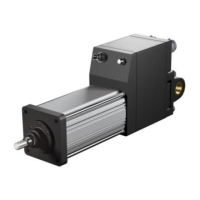Curtiss-Wright | Tritex II DC Rev. J PN49220 2/8/2016
TROUBLESHOOTING PROCEDURES
This section provides you with guidelines and hints on troubleshooting
various problems that may be encountered during installation and
operation of your Tritex Series actuator.
Possible Cause / Troubleshooting Procedure
No response from
actuator.
1. Check drive for faults that may indicate problem via
I/O or Expert software.
2. Check to insure that drive is powered and enabled.
3. Check for proper wiring.
Actuator seems to be
enabled (receiving
current) but is not
operating or is operating
erratically.
1. Drive may be improperly tuned. Check all gain
settings.
2. Check for load irregularities or excess compliance.
Actuator cannot move
load.
1. Load is too large for the capacity of the actuator or
too much friction is present.
2. Excessive side load.
3. Misalignment of output rod to load.
4. Current limit in drive is set too low
5. Power supply has too low of current capacity
Actuator housing moves
or vibrates when shaft is
in motion.
1. Check actuator mounting. Insure that the actuator is
securely mounted.
2. Drive is improperly tuned (wrong gain settings).
Output rod rotates
during motion and thus
does not provide proper
linear motion.
1. Install Exlar anti-rotation assembly or incorporate
anti-rotation into the application.
1. Insufficient cooling for application requirements.
Contact Exlar engineering.
2. Ambient temperature is too high.
3. Actuator is being operated outside of continuous
ratings.
4. Amplifier is poorly tuned causing excessive
unnecessary current to be applied to motor. Check
Gain settings.
5. Over Voltage limit set too low causing internal shunt
control to remain active.

